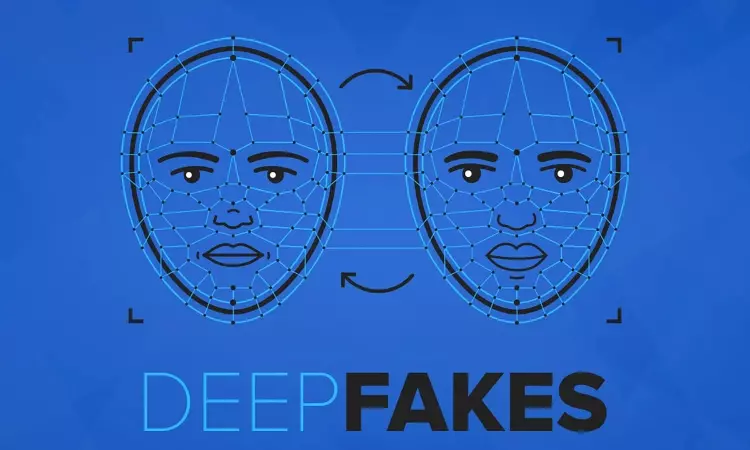Are Deep Fakes Digital Chameleons?
Sanhita Chauriha
30 Sept 2023 3:34 PM IST

In an era dominated by artificial intelligence (AI), a new breed of mischief has emerged - deepfakes. These cunning concoctions, born from the marriage of “deep learning” and “fake,” are causing quite a stir. They have become a riddle wrapped in a puzzle, challenging our perception of reality and posing a profound question: How do we grapple with this digital deception that threatens the very bedrock of truth and authenticity? Let us explore some examples to gain a better understanding of how they are having a profound impact on us.
Women find themselves on the frontlines of a battle against the insidious rise of deepfake pornography. This reprehensible phenomenon involves the malicious use of AI to superimpose the faces of unsuspecting individuals onto explicit and often degrading content, all without their consent. It is a horrifying violation that has thrust victims into a harrowing ordeal of humiliation and violation. However, to fully comprehend the gravity of this issue, we must cast our gaze beyond these distressing personal narratives. Recent headlines serve as stark reminders of the multifaceted nature of the deepfake challenge.
Consider the audacious instance of a fake video featuring Vladimir Putin, purportedly announcing a full-scale war against Ukraine. This fabricated footage was broadcast on Russian television, sowing confusion and stoking geopolitical tensions. Or, look at the 2024 U.S. Presidential election campaign, where deepfake videos inundated social media platforms to sway public opinion. Despite the efforts of major social media giants like Facebook and Twitter to prohibit and remove such content, the effectiveness of these countermeasures remains questionable.
The sinister reach of deepfakes extends further. In a disturbing case in China, a scammer exploited AI face-swapping technology to pose as a friend during a video call, convincing a man to part with a staggering $600,000. This incident highlights the potential financial devastation that deepfake technology can wreak, underscoring the urgent need for safeguards against such exploitation.
And even high-profile figures like Elon Musk have not been immune. Musk was compelled to testify when his own lawyer suggested that his claim about Tesla’s Autopilot system could have been a “deepfake.” This case illuminates how deepfake accusations can infiltrate legal proceedings, adding complexity to already intricate matters.
Beyond individual privacy violations, deepfakes have the power to disrupt politics, elections, finances, and even the legal system. It is within this vast and intricate landscape that we must grapple with the urgent need to confront and combat the menace of digital deception.
Deepfakes represent a formidable evolution in digital manipulation. Driven by sophisticated artificial intelligence, these digital chameleons can seamlessly transpose one person’s likeness onto another person, creating videos and audio recordings that are virtually indistinguishable from reality. While the allure of such technology is undeniable, the implications are far-reaching. They have the potential to undermine the very foundations of trust in information, serving as potent tools for peddling misinformation, sowing discord, and manipulating public opinion. Beyond the realm of politics, deepfakes can be harbingers of personal turmoil, breaching individual privacy by altering images and voices without consent. The consequences are far-reaching, as intimate moments can be ruthlessly exploited for malicious purposes.
Addressing the threat of deepfakes necessitates a comprehensive strategy encompassing technology, education, and legal measures. Advanced AI-driven detection tools are pivotal in identifying manipulated content, flagging potential deepfakes, and alerting users to exercise caution. Simultaneously, public awareness campaigns and media literacy programs empower individuals to distinguish genuine content from manipulated material, fostering a more discerning digital society. Collaboration between tech companies, governments, researchers, and international partners is essential to share insights and tools for countering deepfake threats, ensuring a collective and coordinated response to this evolving challenge. Moreover, ethical AI development and digital forensics expertise play a vital role in verifying the authenticity of content and promoting responsible AI use. By combining these approaches, we can enhance our defences against deepfakes, safeguarding the integrity of digital information and preserving trust in the digital realm.
Top of Form
In India, laws addressing deepfake activities include Section 66E of the Information Technology Act of 2000, which pertains to privacy violations through the capturing, publishing, or transmission of someone’s images in mass media. Violators can face imprisonment for up to three years or a fine of up to ₹2 lakh. Additionally, Section 66D of the IT Act allows prosecution for malicious use of communication devices or computer resources to impersonate others, carrying penalties of up to three years in prison and/or a fine of up to ₹1 lakh. These provisions can be applied to prosecute individuals engaged in deepfake cybercrimes within the country. As the forthcoming Digital India Act aims to supersede the IT Act, it will comprehensively address the threats posed by AI, including the issue of deepfakes. Let us keenly observe how this legislation unfolds in addressing these challenges.
Deepfakes are a bit like magic tricks in the digital world. They can create amazing illusions, but they can also distort reality. To make the most of this technology while keeping it in check, we need a careful balance between innovation and rules. It is a bit like walking a tightrope in a world where what you see is not always what you get.
Sanhita Chauriha is with Vidhi Centre for Legal Policy. Views are personal.


